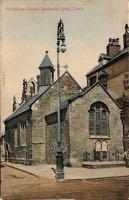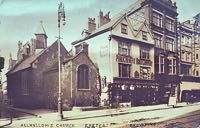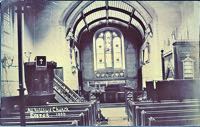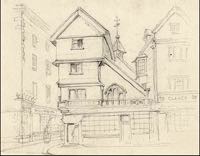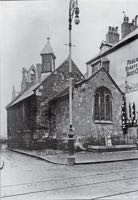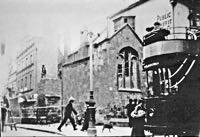
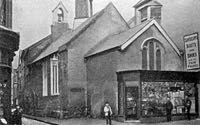 All Hallows Church, Goldsmith Street
All Hallows Church, Goldsmith Street
Page updated 21st May 2018
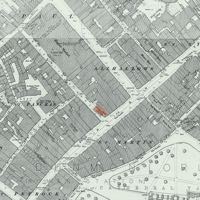 It is difficult to believe
that the entrance to Goldsmith
Street by Ernest Jones (formerly H Samuels), was the site of a
small church until 1905. Carts and wagons, heading for the market,
during the nineteenth century had to enter Goldsmith Street from
Waterbeer Street or Paul Street, such was the narrow width by the
church.
It is difficult to believe
that the entrance to Goldsmith
Street by Ernest Jones (formerly H Samuels), was the site of a
small church until 1905. Carts and wagons, heading for the market,
during the nineteenth century had to enter Goldsmith Street from
Waterbeer Street or Paul Street, such was the narrow width by the
church.
Although in a prominent position at the head of Goldsmith Street, Edith Cresswell considered the church was of no real architectural interest. It consisted of a small nave and chancel, dating to 1380, lit by windows of the same age. The lack of light, due to the surrounding buildings led to a skylight being inserted in the nave in 1822. The tiny, 900 sq ft (83 sq metres) church, had no exterior burial yard requiring many burials to be made under the floor, often one on top of another.
Edith Cresswell thought that the church existed as early as 1191, having been mentioned in Bishop Marshall's mandate of that year. It was also mentioned in a deed of gift in the will of Peter de Palerna in 1222–he left a penny per year to each of twenty eight parish churches, including All Hallows. The church is one of the sixteen mentioned by Bishop Blondy on the very precise date of 6 January 1247. The tower was added in 1546, under the patronage of the Courtenay family, paid for by the sale of the cross and a chalice, that had been sold to William Smyth, goldsmith, for the purpose of building the tower. The first recorded Rector of the parish was Philip de Essewauter, who was appointed on 28 May 1309. The last Rector was the Rev William Hope, appointed in 1882.
Dr Vilvaine
A little over a hundred years later and the fall out from the Civil War affected many Exeter churches. The pro-royalist All Hallows was ordered to be sold, by order of Parliament in 1658, for use as a burial ground or a school. Fortunately, an influential puritan and physician, Dr Robert Vilvaine purchased it on 9 June 1658 for £50 to preserve it for the local people. Vilvaine's parents were buried in the church, under a slab beneath the communion table. He is most noted for founding a 'common brewhouse', that eventually became Norman and Pring's, City Brewery, in Commercial Road. Dr Vilvaine was buried in the Cathedral, not in his beloved church.
By 1752 the tower was in poor condition, and was removed in 1767 to be replaced by a belfry with a single bell. The bells were sold to St Sidwell's for 8d per pound weight. By the late eighteenth century the church had fallen into disuse, and between 1807 and 1822, services were held in St Stephens.
The church owned 10 acres of glebe land which jointly supported All Hallows and St Pauls, realising £180 annually for running the two churches.
Restoration
By the middle of the 19th-Century, the Revd. Charles Worthy* embarked on a restoration of the small church, during which, a mummified cat was found among the roof beams. The Revd. William Hope had a new floor and oak seating installed in 1883, and in 1887, the entrance was moved 12ft away from the High Street, and the west wall was rebuilt. The Royal Coat of Arms and plaque were fixed above the font.
The west wall of this church was rebuilt and a new window inserted to the glory of God and to mark the completion of the 50th year of the illustrious reign of her most gracious Majesty Queen Victoria, 20th June, 1887
The end
The siting of the church was proving to be a problem
for access to Goldsmith Street. A memorial was read, in 1871, to the
Streets Committee requesting that the church be removed. No further
action was taken at the time, but in 1874, the Committee recommended
that a notice be put up requesting that carts and waggons travelling to the
Higher Market should enter the street via Waterbeer Street, and leave
by Paul Street.
For the next twenty-years, the
Streets Committee returned several times to the problem of widening
Goldsmith Street, but All Hallows Church prevented the work being done. In February 1904, it was announced that the City Council was to purchase the church for £3,000, with the aim of demolition. It was noted that the narrow entrance had proved to be dangerous, when a recent accident had resulted in a fatality–finally the decision was taken to demolish the church and the
last service was held on 10 December, 1905.
Demolition of the church commenced in March 1906. The remains of almost a hundred people were carefully disinterred from vaults beneath the floor. The last body to be removed, on the 9 April 1906, was that of Thomas Westlake, who was Town Clerk of Exeter, between 1648 and 1660. The Council paid £8 5s for the burials in the church to be moved to Higher Cemetery, and a All Hallows memorial stone was erected. Furnishing from the church was transferred to St Pancras, including a Jacobean pulpit and the tablet memorials dedicated to the two victims of smallpox. The Tudor pulpit is now in St Pancras, in the Guildhall Centre.
Monuments and Burials
Alexander Jenkins wrote in 1805:
"In the papal times there was an image of the blessed Virgin, before whom candles were kept perpetually burning; the expences of which were defrayed by an estate near Duryard, appropriated for that purpose: this image was much resorted to by the superstitious, and brought great profits to the Rector; it was destroyed at the Reformation."
Graves in the church included those of the already mentioned Thomas Westlake, gent who died in 1665, Stephen Vilvaine died 1556, Simon Gandy, died 1678, Thomas Bampfylde died 1656, and Peter Vilvaine, died 1602, the father of Dr Vilvaine. It was also the burial place of Thomas Gibbon, Recorder of Exeter from 1684 to 1688. George Arden, a wealthy wool merchant was buried in All Hallows in 1823, while his wife, Joan, was the last to be buried in the church during 1832.
Small-pox
The monument of white marble, consisting of a square tablet, and two skulls, conjoined with bats' wings was moved to St Pancras Church when All Hallows was demolished. It describes the fear of small-pox that periodically raged through the city.
Loveday the daughter of Christopher Bellet late of Bochim in the County of Cornwall Esqr. by Bridget the daughter of William Pendarves of Roskrow in ye sd county, Esqr. lyes buried near this place. She died in this city the 16 day of Septr Anno Dom. 1711 of ye small-pox a distemper so remarkably fatal to her family that no less then (sic) four of her sisters died of it in the months of Feb and March 1716-17 in the Borrughs of Penryn and Fawy in Cornwall aforesaid.
Near to daughter Loveday's remains, her sister Bridgett, the wife of Sampson Hele also lay, another victim of small-pox.
The Parish Registers for All Hallows go back to 1809, while transcripts of the registers for marriage and burials go back to 1561, and baptisms to 1566.
Sources: British History on-line, Alexander Jenkins,The British Newspaper Archive, Exeter Churches by Edith Cresswell.
* The author of The History of the Suburbs of Exeter: With General Particulars)
│ Top of Page │
